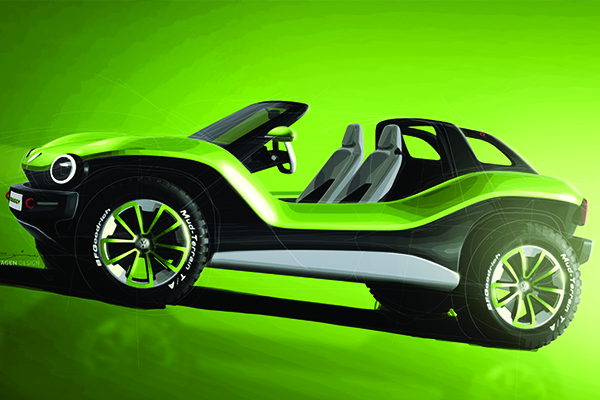
Focus on VOLKSWAGEN’S ID. FAMILY
Volkswagen has not been a pioneer in the market for electric cars, but fully intends to catch up with a complete and attractive range. For several years now, it has been making its move with a series of concept cars.
On 8 May, in Berlin, Volkswagen officially launched its attack on the electric vehicle front. It was undoubtedly one of the major industrial events on the automotive calendar: the ID.3 will be officially unveiled during the Frankfurt Motor Show in September, but the advertising campaign is now under way and orders can be placed. After just 24 hours, 10,000 orders had already been recorded.
The only model available, on sale for under 40,000 €, the ID.3 First offers a range of 260 miles (420km) with its intermediate-spec battery (54kWh). It will soon be joined by two other versions of 45 and 77 kWh, offering a range of 205 and 340 miles (330 and 550km) respectively. The first ID.3s, built in Zwickau, will be delivered at the start of 2020.
The ID.3 saloon will be the first to use the new modular MEB platform dedicated to electric cars. It will replace the e-Golf which was merely an adaptation of the model with an internal combustion engine.
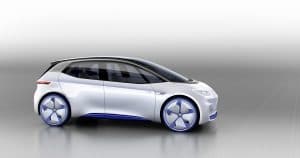
Autodesk VRED Professional 2016 SP1
It had already been possible to imagine the shape of the ID.3 from the ‘ID’ concept car which was displayed at the Paris Motor Show in September 2016. The design of this prototype marked a major stylistic change for Volkswagen with its less rigid lines. Powered by a 170bhp engine installed at the rear, the ID was capable of covering 250 – 375 miles (400-600km) before being recharged. With a simple press on its central logo, the steering wheel retracted and the car became fully autonomous. At 161in (410cm) long, the ID remained compact. The range was then rolled out over the following months.
It was this concept car which served as a first draft for the ID.3, launched in 2019.
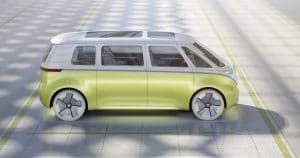
Autodesk VRED Professional 2017 SP1
ID Buzz, January 2017
The second link in the chain of ID projects, the ID. Buzz was presented at the Detroit Auto Show in January 2017. After the Microbus in 2001 and ‘Bulli’ in 2011, Volkswagen offered another interpretation of its legendary Kombi, which made its appearance in 1950. Despite the absence of round headlamps, the ID. Buzz instantly calls to mind its predecessor so beloved of the hippy generation. With an electric motor developing 275kW, it has a range of 370 miles (600km) and can accelerate from 0-62mph (100kph) in 5 seconds, on its way to a top speed limited to 99mph (160kph). With room for eight passengers in its modular interior, it can provide autonomous transport. Production is scheduled to begin in 2022.
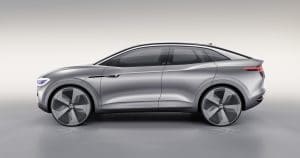
Autodesk VRED Professional 2017 SP1
ID. CROZZ, april 2017
Expected to join the range in 2020, the ID. Crozz is an electric SUV with a range of 310 miles (500km) which can reach a top speed limited to 112mph (180kph) and can be recharged to 80% of its capacity in 30 minutes, by means of a rapid charging system. First presented finished in grey at Shanghai in April 2017, it switched to red for Frankfurt, where it received a new design of wheel, as well as front and rear-end styling closer to the final model. It has a 306bhp electric powertrain.
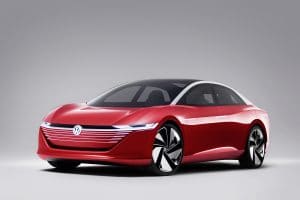 ID.Vizzion, march 2018
ID.Vizzion, march 2018
Expected to join the range in 2020, the ID. Crozz is an electric SUV with a range of 310 miles (500km) which can reach a top speed limited to 112mph (180kph) and can be recharged to 80% of its capacity in 30 minutes, by means of a rapid charging system. First presented finished in grey at Shanghai in April 2017, it switched to red for Frankfurt, where it received a new design of wheel, as well as front and rear-end styling closer to the final model. It has a 306bhp electric powertrain.
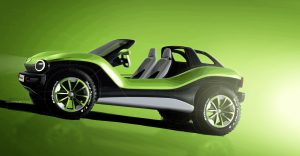 ID.Buggy, mars 2019
ID.Buggy, mars 2019
Who can still remember the beach buggy? If we stick to etymology, the English term ‘buggy’ refers to a cart with four wheels and a simple structure with low panels on each side. The original buggy faded away over many years … until a number of American craftsmen came up with the idea of creating a toy based on Volkswagen mechanicals, As their name suggests, these cars were intended to be used for pleasure in the sand dunes of the American West. They had bodies reduced to a minimum, mounted on top of large wheels to ensure a high ground clearance and so improve their ability to cross rough ground while making do with two-wheel drive. The inventor of the beach buggy was a specialist in plastic structures by the name of Bruce Meyer.
The beach buggy became popular thanks to Steve McQueen, who could be seen bouncing across the dunes in just such a vehicle in a famous scene from the film The Thomas Crown Affair.
The current version, first shown at the Geneva Motor show last March, has switched to electric power with a motor producing 204bhp.
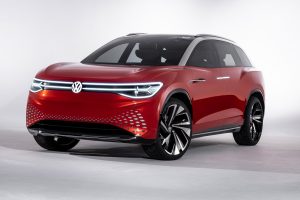 ID.Roomzz, avril 2019
ID.Roomzz, avril 2019
It is hard not to include an SUV in a range of cars today. Accordingly, Volkswagen showed this concept, fitted with sliding side doors, to visitors to the Shanghai Auto Show. 194in (492cm) long, the ID. Roomzz has four reclining seats which can be rotated through 25 degrees. This function only operates in the ‘ID. Pilot’ mode, used for autonomous driving when the driver is no longer obliged to remain behind the steering wheel.
